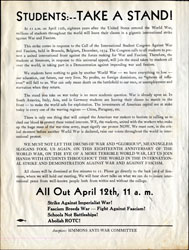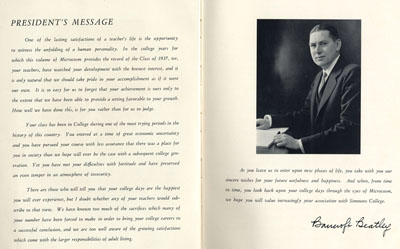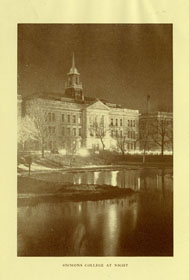Historical Context
The United States and Beyond

Flyer advertising a protest against US involvement in World War II. Calls for Simmons students to stage a walk out and hold an anti-fascism rally.
Source: Jean Elizabeth Goodrich Scrapbook
In the 1930s, there were 48 states in the United States, milk cost 14 cents per quart, and the average salary was $1,368. The country was going through a time of upheaval and great changes were occurring. Prohibition, which began in 1920 with the ratification of the 18th Amendment, was repealed on December 5, 1933 through the enactment of the 21st Amendment. Even though Massachusetts had already voted in 1930 to repeal the enforcement of prohibition in the state, this change in the law had an impact on both crime and the economy in Boston. As evidenced by the matchbooks and souvenirs in the scrapbook, bars and burlesque clubs were both legal and frequent locations for students to visit during the 1930s.
Another issue that affected life in the United States, and the world as a whole, in the 1930s was the Great Depression. By 1933, unemployment rates in the country reached 25% and many people's finances could not cover even the most basic of needs. When President Roosevelt was sworn in on March 4, 1933, his New Deal sought to reform the economy and assist those who were struggling. This same year, Thomas Yawkey bought the Boston Red Sox and the U.S. Federal Deposit Insurance Corporation (FDIC) was created. Outside the United States, 1933 was also a year of great transition, with Adolf Hitler elected to power in Germany, the rise of the U.S.S.R., the overthrow of the Cuban government, and much more. It was during this time that Bettie came to Simmons and began her studies.
As the 1930s progressed, things in the United States began to stabilize. However, the rise of the Nazis and general discontent throughout Europe and Asia was felt by all, including Simmons students, who held a protest against fascism in 1934. By the time Bettie had completed her studies at Simmons, the world was on the verge of war and a new era was beginning.

This 1937 yearbook page contains a message from Bancroft Beatley, President of Simmons College, to the senior class. In the second paragraph he states, "Your class has been in College during one of the most trying periods in the history of this country," a grave reflection of the financial realities of the 1930s.
Source: Simmons College. (1937). Microcosm: 1937. Andover, MA: Andover Press.
Simmons College History

A picture of the Simmons Campus at night, published Spring issue of the literary magazine when Bettie was the technical editor.
Source: Simmons College. (1937). Per-Simmons: 1937. Boston. Simmons College.
While things were changing for the country as a whole, Simmons College was also going through a time of transition during the 1930s. President Henry Lefavour, who had been serving at the school since 1902, was in poor health and stepped down from office in early 1932. Dr. Bancroft Beatley, formerly Associate Professor of Education at Harvard University, was elected to the presidency of Simmons College on June 9, 1932. Due to the poor economy, income from tuition and from investments decreased from 1932-1933 and five percent of all salaries for 1933-34 were withheld. At the same time, students who had been enrolled at the school for at least two years were not forced to leave if they had difficulty paying the tuition. Student loans increased and graduates who were unable to find employment were allowed to continue taking advanced courses at no charge. Due in part to the economy, enrollment at Simmons went from 602 students in residence in 1932 to just 443 in 1933. Several of the dormitories were closed and the holdings were eventually sold in 1936. Despite all of this, the school remained financially stable and was able to pay the withheld salaries back to the staff in 1936.





